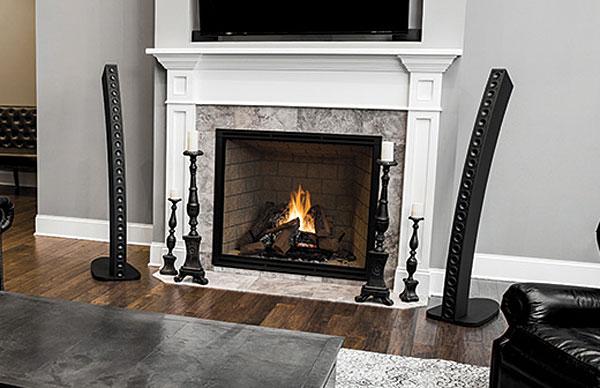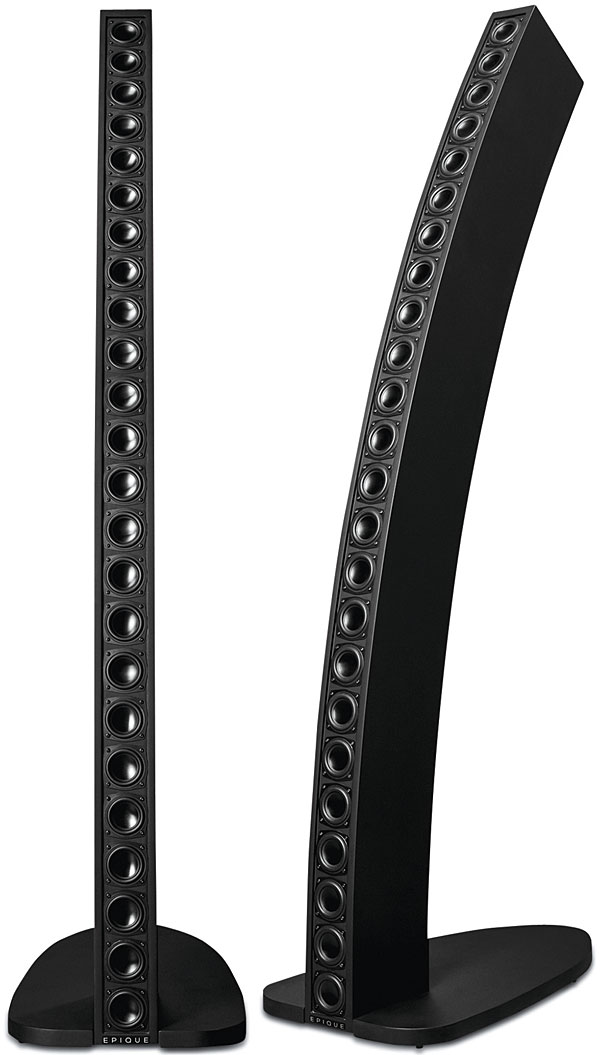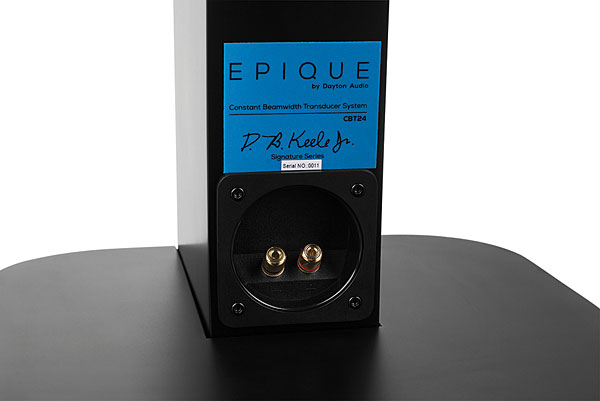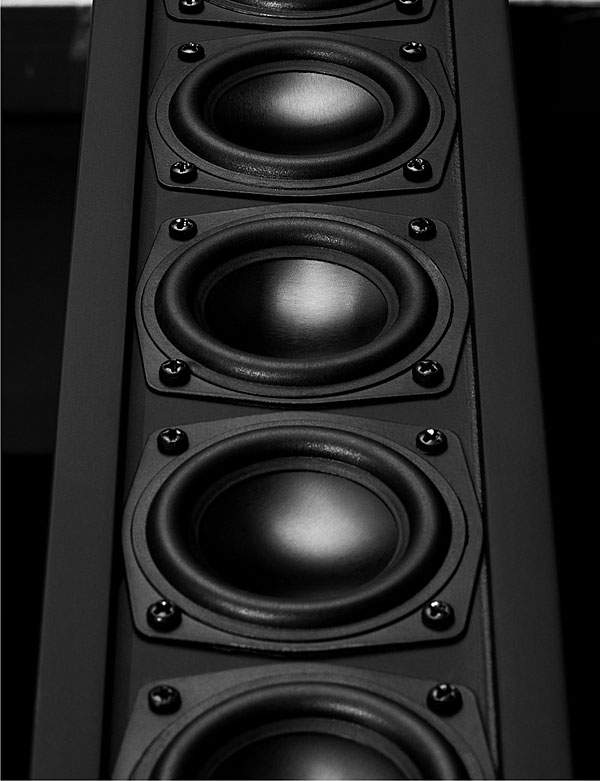I hate to say this but I quit reading after the reviewer said he "opted for the assembled version" as he isn't paid enough or something along those lines. No wonder hobbyist kit audio died! Now in most ways that doesn't make the review of the speaker less pertinent as far as capabiliteies, but it completely misses the ethos of a segment of the audio market that is needing a big boost for a renaissance. And a speaker like this could be a kickstarter of a whole other generations DIY audio love affair. Nevermind...I should be glad the speaker exists I guess.
Dayton Audio Epique CBT24 Speaker System Review

AT A GLANCE
Plus
Remarkable, panel-speaker-like stereo imaging
Neutral tonal balance
Complete absence of “floor-bounce” thickening
Minus
Curtailed bass requires subwoofer support
Needs custom- or auto-equalization for best performance
Modest subwoofer localization
THE VERDICT
A genuine rarity—a truly distinct take on consumer loudspeaker design— Dayton Audio’s Epique CBT24 delivers exceptional performance with exceptional stereo imaging. Extremely unusual looks and the need for modest equalization and a subwoofer shouldn’t deter adventurous listeners.
And now for something completely different: Dayton Audio’s Epique CBT24.
What’s an Epique CBT24? A 24-driver, no-crossover, one-way tower loudspeaker that stands 5 feet tall yet is no more than 3.5 inches wide over its full, dramatically arched length. A tower speaker with a unique geometry, pedigree, visual aesthetic, and equally unique technical story (and even marketing plan).
The CBT24 is the first product in a new Epique line offered by Dayton Audio and is sold via that brand’s Parts Express website (parts-express.com), known for its array of direct-to-consumer parts, drivers, kits, and audio products for the value and DIY buyer. Like many of Dayton’s speakers, Epique is offered in both assembled and kit forms. (We opted for the former: They don’t pay me enough to screw 48 tiny drivers into baffles and then wire them without making a mistake, and as for woodworking…).
But in point of fact, the CBT24 reviewed here, is entirely the baby of D.B. Keele, a well-known electrical engineer and all-around hi-fi mad scientist who has worked at various times for Harman (the JBL parent), Electro-Voice (twice), and Crown/Techron (where he developed the TEF spectrum analyzer) and Klipsch. Yet, if the name sounds familiar, it’s most likely because Don Keele was also Senior Editor and lead loudspeaker reviewer for Audio—the most technical of S&V’s several progenitors—through much of he 1990s. Full disclosure: I also freelanced for Audio at roughly the same time. I admired Don’s work, and though we met only at trade shows, he was unfailingly and cheerfully generous with his time and his seemingly limitless knowledge and expertise, which I occasionally solicited by phone and for which I was grateful then and remain so today. That said, we’ve neither met nor conversed for at least a decade.

The CBT24 is the commercial manifestation of an acoustical principle Keele has been refining for decades, the constant-beamwidth transducer; a concept enshrined right in the speaker’s name. The concept, which was put forth in a U.S. Navy technical paper from 1978 that became the basis of all of Keele’s later research (more than a dozen AES papers in all), describes a sound source whose spectral content, and thus its perceived timbre, remains substantially unchanged whether you hear it (or measure it) from straight ahead or off axis to one or the other side. This is a popular speaker-design goal—difficult to realize via conventional designs—because in typical listening rooms much of what we hear is reflected sound from a speaker’s off-axis output, and if this is substantially different in tonality than the direct sound reaching our ears straight from the loudspeaker, the realism suffers.
Another design ideal is to eliminate sound vertically off axis, that is, angled toward the floor and ceiling. These surfaces, especially the floor, are usually much closer to the speaker than the walls are. The speaker is, in most cases, standing on it, so the floor is the closest of all. In nearly all conventional designs, this induces “floor-bounce” as this first-reflection sound bounces back into the path of the direct output. It interferes both by reinforcing frequencies whose wavelengths are close to this reflection’s total angular distance and by attenuating adjacent ones. (The mechanism is analogous to interfering ripples in still water: Throw a quarter into a swimming pool near one wall, and watch the patterns as the ripples bounce off the wall, creating areas of deeper waves and regions of flat water.) Floor-bounce usually results in a strong peak/dip somewhere around 150 to 300 hertz, usually with adjacent ripples, that combine for the strongest single coloration in the vast majority of real-world installations.
Keele’s CBT24 claims to address both of these issues with constant-beamwidth transducer magic. His design places 24, 2.5-inch drivers, spaced as closely as their physical dimensions allow, along an arched baffle just 3.5 inches wide, which describes about 36 degrees of the arc of a vertical circle. A circle whose diameter, its chord measuring some 60 inches…I could tell you if I could remember more—any—of my high-school trigonometry.)
Every one of the 24 drivers is run equally full-range, unfiltered by any crossover, but they are not driven equally full-level. Divided into three amplitude “shelves” dictated by a mathematical arcana called the Legendre function, the drivers nearest the floor, at the bottom of the arc, play full-level, with groups of drivers higher up stepped down by roughly 3.5 and 8 decibels. The CBT24 does this passively, through clever series-parallel driver wiring arrangements and just a couple of carefully specified resistors. (The mathematical ideal calls for smoothly attenuating level; while this could be accomplished via DSP and individually addressable driver inputs, you’d still need 48 channels of amplifier power.) As I understand things, this “shading” of levels (combined with the curved physical array) is a critical factor in transforming a tightly packed column of drivers, whose outputs interact with one another and lobe wildly, into a coherent line source with astonishingly constant directivity and broad, wide-frequency coverage, though exactly how (and why) the math works here is well over both my head and my pay grade.

Now, in actual fact, the CBT24 is only half of a constant-beamwidth source: A full example would have the unattenuated drivers smack in the center (height-wise) and “shade” descending levels toward both ends. But it turns out that because the line of transducers extends right down to the floor, and since the floor is, at the lower frequencies that matter most, a near-perfect acoustic reflector, the behavior of this “half-CBT” is nigh on indistinguishable from what a full-array CBT would deliver, at substantially less cost and with real-world-acceptable height (a full CBT of the 24’s design would be some 11 feet tall). This, at least, is Keele’s assertion. (Imagine half of a light bulb placed flat on a perfectly mirrored floor; it would appear, and illuminate, exactly like a full light bulb. The principle’s the same.)
Setup
But you didn’t come here for a lecture on acoustical physics (though there’ll be a quiz next Thursday). You came here to learn what the CBT24 sounds like. The answer— or answers, since there will be multiples—are not quite so simple.
Multiples, because Dayton Audio freely admits that the CBT24 requires equalization to show its best. To that end, they, in their Parts Express persona, also loaned us a miniDSP, an inexpensive ($105) two-channel 2-in/4-out digital equalizer. This is mostly used by speaker hobbyists as an outboard digital crossover/equalizer/delay, but in this case, Dayton preprogrammed it with simple, stereo-in/out compensation for the CBT24’s roll-offs at both the bass and treble extremes. I had no data for this smile-shaped curve, nor did I measure it (see our measurement results in the Test Bench box), but the data set is downloadable from Dayton’s Epique page for you and yours to tap as needed. The company also claims that you can get fairly close with simple tone controls, though I feel the need to point out that tone-control curves can vary a good deal from design to design and often change “shape” from low to high settings, so I should think Dayton’s designed, downloadable EQ is clearly preferable. In the absence of this, and perhaps as a preference to this, Dayton also recommends the auto room-correction scheme in virtually every modern A/V receiver, which I also tried and about which I’ll say more later. As for the bass end of things, I determined that my long-term sub, the SVS PB12-Plus—a cylindrical design with massive output to below 20 Hz and very flexible crossover/filtering facilities—would suffice for the “with-sub” portion of the program.
I set up the CBT24s in my studio’s usual tower locations, about 9 feet apart and some 3 or 4 feet from the front wall at floor level—this put the backwards-arcing top within a foot of the wall—and 10 or 11 feet from my listening seat. The speakers arrive with simple wooden bases that screw securely into their bottom ends (you’ll want a power-driver, as the screws are long and fine-pitched), and despite their somewhat entomological look, the CBT24s proved perfectly stable, even on my room’s carpeting. The CBT24 bases have no provisions for floor pads or carpet spikes, and I employed none, but adding either would be a simple matter. (My sub remained in its long-proven location, to the right of and behind the right speaker.)
The CBT24s are plainly finished in semi-gloss black enamel, with nary a visual bell nor whistle. There’s no grille, so the main visual element is that arc of 24 little, dark gray, inverted domes. It’s a look that’s unlikely to turn up as a prop in an Architectural Digest shoot any time soon, but after a few days’ acclimatization, I came to quite appreciate it. Your taste may vary.
Listening...and More Listening
I began my evaluation with simple, unprocessed (no EQ), full-range stereo with no subwoofer. Listening from a typical position about 10 feet distant—and trying to think the speakers out of sight behind an imaginary screen— I heard what might have been a very respectable but substantially bass-limited mini-monitor, though one with an unusually broad stereo image. There was not much bass below 120 Hz or so, so pop/rock like Greenday’s “Longview” sounded decidedly light, and top-treble air and sparkle were very slightly reduced from the levels I’m accustomed to hearing from typical “hi-fi” speakers. But, otherwise, the over-all tonal balance, subjectively speaking, was devoid of any strong colorations.

I did a good deal more listening to the CBTs naked and alone (the speakers, not me) to get a good handle on them, but I won’t spend too many words on that here: Without subwoofer reinforcement and modest but important EQ correction, the limited low range and slightly curtailed treble extension obviate the need for much discussion. With the miniDSP connected and engaged, however, things were considerably different. Now the Daytons evinced the kind of sparkle and air we expect from high-end loudspeakers, such that a recording like my CD-resolution rip of the Sheffield Drum Record sprang fully to life, with snare hits cracking with authority and cymbal rides floating, fully detailed, above.
The next step, obviously, was to add the subwoofer. As supplied by Dayton Audio, the miniDSP EQ/crossover was a classic black box. I had no data as to its crossover point, filter, or EQ curves, so I was left to balance my SVS sub, connected by its unfiltered line input, with level alone, by ear. A surprisingly little amount of fiddling yielded a very satisfying blend. The crossover point, at a guess set somewhere between 100 and 150 Hz, was slightly higher than I might have preferred were the CBTs able to muster a tad more bass extension. It left just a breath of noticeable sub localization on lower-frequency voices or instruments if I sat much closer than my usual 10 to 11 feet, or if I balanced the sub higher than my usual, quite lean preference—but otherwise the blend was excellent.
And so was the net result. With solid bass underpinning, the CBTs’ midrange clarity and depth sprang into sharp focus on material like Paul Simon’s “Under African Skies,” delivering impressively detailed sonic texture and delineation of musical lines, as well as convincing dynamic snap.
- Log in or register to post comments


These speakers appealed to me on many levels. I wanted something a little different than a traditional box design, I value imaging and sound staging. The value offered in a kit and the fact that they were on sale made it a no brainer for me.
The kit arrived in three boxes, one for the drivers and two long boxes with the assembled cabinets. Everything was laid out nicely, although they did forget 8 screws for the base, which were easy to get at Home Depot for a dollar. Finishing the cabinets took the longest time. I just painted them satin black but the MDF took three coats to look good. Cabinet walls were pretty thin so I applied a couple of tubes of silicone sealer to the sides and back to try to deaden them a little bit. Don't know if that did anything, but I felt better about it. A couple of things. The instructions say to attach the terminal cup first, if you do that you can't attach the wires to the terminals. Also, I would not use a power screwdriver for the drivers, it can be easy to strip the MDF, thought it took some time I did it by hand. The wiring harness was very nice and set up so you can't mess anything up, all numbered, and different sized connectors for positive and negative. I spent a couple of days finishing them, final assembly took about 5 hours. I certainly wouldn't expect a reviewer to go through this effort.
I have a Marantz AV processor with the current version of Audessey, and a pair of Infinity IM1.2 subs. Audessey set the crossover at 150 hz, which I expected. I have an Odyssey Kismet power amp, which seems to mate very well with these speakers.
I love the sound, unlike in the review I do get some sounds outside the edges of the cabinets, but the depth and detail of the image is superb. It's trite I know but I hear new things in recordings I am most intimately familiar with, such as Santana Caravanserai. King Crimson Island. The lack of floor bounce gives great detail to stand up bass. No problem with subwoofer localization, and with EQ the high end is very nice and extended, though perhaps not as transparent as a ribbon. They are VERY dynamic, with sounds seeming to leap from the speakers. Vocals are creamy, and float in front of you.
I like them a lot. I still need to play with the amplification. Part of the reason I bought these is that I have an HK990 amp, which has an EQ function optimized more for stereo and it uses near field measurements for speaker EQ and far field at the listening position for sub EQ. I am curious to see if it improves the sound.
I was thinking about re-doing the wiring harness with better wire and better resistors, but looked like more of a project than I wanted to embark on. I have ordered some snazzy rhodium speaker binding posts because the ones included are quite cheap, as you would expect. I don't think they will make any difference, but I thought what the heck.
These are not the most transparent speakers, like an electrostatic or ribbon, but the lack of floor bounce really adds to the bass detail. They are able to produce a large sound field that is enveloping and elicits that thing I seek, emotional involvement.
I am very happy with my pair.

>> Complete absence of “floor-bounce” thickening
1) There is no gravity involved and the sound does not fall: the floor reflections are no different from those off the front and near sidewall. (The near corner, in other words.) There are 7 such reflections in all. The so-called direct floor reflection, mislabeled bounce, is but a single one of the 7.
2) The Keele design acts no differently with regard to the absence of lower-midrange suckout (lower mid, not a bass issue) than any other speaker whose woofer(s) are near the floor. There is nothing magical going on here, in other words, although to my ear this design is pretty transparent, and yes, it is indeed helped by not having the common lower-midrange notch.
3) There is almost never any thickening going on; it is almost invariably a power response suckout or notch in the octave below middle C. Allison analyzed and designed around this problem 45 years ago, but it remains widely ignored, albeit recognized, by modern designers. It's easy to overlook with modern FFT/TDS-based measurement technologies, btw.





































































